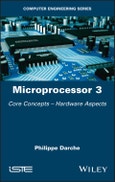Table of Contents
Quotation ix
Preface xi
Introduction xv
Chapter 1. Basic and Historical Definitions 1
1.1. Basic definitions 1
1.2. History 3
1.3. Conclusion 15
Chapter 2. Microprocessor Interfacing 17
2.1. Microprocessor bus 17
2.1.1. Address bus 18
2.1.2. Data bus 22
2.1.3. Control bus 23
2.2. Hardware interface 23
2.3. Peripheral logic 24
2.4. Temporal aspects 25
2.4.1. Clock 25
2.4.2. Exchange protocol 34
2.4.3. Asynchronism 37
2.5. Conclusion 38
Chapter 3. Internal Constitution 39
3.1. Registers 39
3.1.1. Definition 40
3.1.2. Accumulators and auxiliary registers 44
3.1.3. Program counter 45
3.1.4. Instruction register 46
3.1.5. Status and control register 46
3.1.6. Index register 53
3.1.7. Indirection register 54
3.1.8. Stack pointer register 54
3.1.9. Special registers 54
3.1.10. Synthesis 55
3.1.11. Register structures 56
3.1.12. Notions related to registers 60
3.2. Internal memories 63
3.3. Integer processing unit 63
3.4. Control unit 69
3.4.1. Internal states 70
3.4.2. Generation of internal synchronization signals 72
3.4.3. Phases of the execution cycle 74
3.4.4. Other subsets 77
3.5. Bus interface 78
3.6. Note 79
3.7. Conclusion 79
Chapter 4. Commercial Microprocessors: From a Single Bit to 128 Bits 81
4.1. Single-bit microprocessor 81
4.2. 4-bit family 82
4.3. 8-bit family 85
4.4. 12-bit family 92
4.5. 16-bit family 92
4.6 32 bits 94
4.7. New generations 99
4.8. Conclusion 101
Chapter 5. Special Cases 103
5.1. Bit-slice processor 103
5.2. Digital signal processor 104
5.3. Microcontroller 112
5.4. Coprocessor 119
5.5. Parallelism processors 122
5.6. Conclusion 123
Chapter 6. Datasheet 125
6.1. Electrical specifications 125
6.1.1. Supply voltage 125
6.1.2. Power consumption 127
6.1.3. Power supply profiles 128
6.1.4. Energy savings 130
6.1.5. Peripheral components 133
6.2. Processor hardware initialization 134
6.3. Mechanical, electrical and thermal aspects of the package 135
6.4. Conclusion 137
Conclusion of Volume 3 139
Exercises 141
Appendices 151
Acronyms 155
References 179
Index 193








